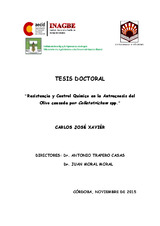Resistencia y control químico en la Antracnosis del olivo causada por Colletotrichum spp.
Autor
Xavier, Carlos José
Director/es
Trapero Casas, AntonioMoral Moral, Juan
Editor
Universidad de Córdoba, UCOPressFecha
2015Materia
AntracnosisAceituna jabonosa
Olivo
Collectotrichum spp.
Andalucía
Fungicidas
METS:
Mostrar el registro METSPREMIS:
Mostrar el registro PREMISMetadatos
Mostrar el registro completo del ítemResumen
La Antracnosis o Aceituna Jabonosa, es la enfermedad más importante del fruto del
olivo y origina pérdidas estimadas en unos 75 millones de euros en España. La
Antracnosis está causada por varias especies de hongos del género Colletotrichum
pertenecientes a los complejos Colletotrichum acutatum sensu lato (s.l) y Colleotrichum
gloesoporiodes s.l. En Andalucía, las especies más frecuentes asociadas con la
Antracnosis pertenecen al complejo C. acutatum s.l. La enfermedad presenta dos
síndromes característicos, el primero es la podredumbre del fruto de aspecto jabonoso
que puede avanzar hasta afectar al fruto completo y que termina por momificarse. El
segundo síndrome es la muerte y desecación de ramas y está asociado a las toxinas que
produce el patógeno en las aceitunas afectadas y que se movilizan a las ramas. Además,
los aceites obtenidos de aceitunas afectadas muestran pésimas características químicas y
sensoriales, no apto para el consumo, conocidos como aceites colorados. A pesar de que
la enfermedad es bien conocida por sus efectos en zonas de clima mediterráneo, todavía
existen lagunas en su conocimiento. Por ello, en el presente trabajo se planteó el
objetivo de revisar y actualizar toda la información sobre la Antracnosis del olivo y su
efecto en la calidad del aceite.
El desarrollo de la enfermedad está condicionado por la resistencia de la variedad. En
los últimos 15 años se han registrados cuatro graves epidemias en Andalucía y dado el
desconocimiento de la susceptibilidad de los cultivares de olivo a esta enfermedad,
permitieron que en el grupo de Patología Agroforestal de la Universidad de Córdoba se
pusieran a punto métodos de evaluación de susceptibilidad en condiciones controladas y
de campo. Por ello, como segundo objetivo de esta tesis se ha completado la evaluación
de las variedades de olivo en las parcelas principales del Banco Mundial de
Germoplasma de Olivo, localizadas el Centro “Alameda del Obispo” del IFAPA en
Córdoba. En total, se han evaluado 384 cultivares y se han establecido 5 categorías de
susceptibilidad/resistencia: altamente resistentes (8.9%), resistentes (14.3%),
intermedios (19.8%), susceptibles (31.5%) y altamente susceptibles (25.5%). Los
cultivares representativos de cada uno de estos grupos son Frantoio, Picual, Arbequina,
Lechín de Sevilla y Ocal, respectivamente. Los resultados de este estudio son de gran
interés para futuras plantaciones de olivo y para desarrollar estrategias de control
integrado para esta enfermedad... Anthracnose of olive (Olea europaea) is the most important disease of the olive fruit
causing losses estimated of ~ 75 million euros in Spain. The disease is caused by several
species of the fungal genus Colletotrichum, mainly the species complex Colletotrichum
acutatum sensu lato (s.l.) and Colleotrichum gloesoporiodes s.l. In Andalusia, the most
common species associated with olive anthracnose is C. acutatum s.l. Olive
anthracnosis has two characteristic disease syndromes. The first one is the fruit rot with
soapy appearance that can progress causing its mummification. The second syndrome is
and drying and death of branches and it is associated with toxins produced by the
pathogen in affected fruits that are mobilized to the branches. In addition, olive oils
from affected fruits, known as red-colored oils, show awful chemical and sensory
characteristics, so they are not suitable for consumption. Although the disease is well
known by its effects in Mediterranean areas, there are still gaps in the knowledge about
it. Therefore, in this study we have reviewed and updated the information about
anthracnose and its effects on olive oil quality.
The resistance or susceptibility of the olive cultivar is the main factor determining the
development of this disease. In the last 15 years, four serious anthracnose epidemics
have been registered in Andalusia and given the lack of knowledge about the
susceptibility of the olive cultivars to the disease, the group of Pathology Agroforestry
University of Cordoba developed methods to evaluate it in controlled and field
conditions. Therefore, as a second objective of this thesis, we have completed the
evaluation of olive cultivars in the main plots of the World Olive Germplasm Bank of
Córdoba (WOGBC), located in the "Alameda del Obispo" IFAPA Center in Córdoba
(Spain). In total, we have evaluated 384 cultivars and established five categories of
susceptibility/resistance: highly resistant (8.9%), resistant (14.3%), intermediate
(19.8%), susceptible (31.5%) and highly susceptible (25.5%). Representative cultivars
of each of these groups are „Frantoio‟, „Picual‟, „Arbequina‟, „Lechín de Sevilla‟ and
„Ocal‟, respectively. The results of this study are of great interest for future olive
plantations and to develop integrated strategies to control this disease.
The lack of knowledge about the susceptibility of the wild olives to anthracnose, led us
to undertake field surveys in Andalusia, in which no disease symptoms were observed,
although some wild olives showed latent infections. Therefore, the resistance of 45 wild
olive genotypes and the possible transmission of the pathogen to the seed were...

